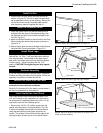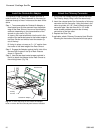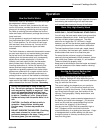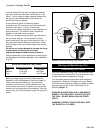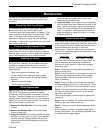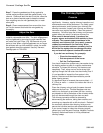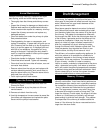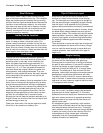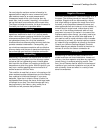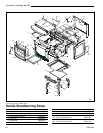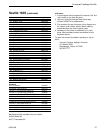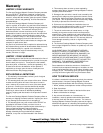
24
Vermont Castings Seville
30001490
Pipe & Chimney Layout
Every bend in the flue will act as a brake on the
exhaust as it flows from the firebox to the chimney
cap. The ideal pipe and chimney layout is straight up
from the stove through a completely straight chimney.
Use this layout if at all possible as it will promote
optimum stove performance and simplify maintenance.
If the stovepipe must elbow to enter a chimney, locate
the elbow about midway between the stove top and
the chimney thimble. This configuration lets the smoke
speed up before it must turn, keeps some pipe in the
room for heat transfer, and allows long-term flexibility
for installing a different appliance without relocating
the thimble.
There should be no more than eight feet of single-wall
stove pipe between the stove and a chimney. Longer
runs can cool the smoke enough to cause draft and
creosote problems. Use double-wall stove pipe for
longer runs.
Single Venting
Your stove requires a dedicated flue. Do not connect
the stove to a flue used by any other appliance.
Chimney draft is a natural form of energy and follows
the path of least resistance. If the stove is vented to a
flue that also serves an open fireplace or another
appliance, the draft will also pull air in through those
avenues. The additional air flow will lower flue tem-
peratures, reduce draft strength and promote creosote
development; overall stove performance will suffer.
The effect is similar to that of a vacuum cleaner with a
hole in the hose. In some extreme instances, the other
appliance can even impose a negative draft and result
in a dangerous draft reversal.
Fuel
Even the best stove installation will not perform well if
poor fuel is used. If available, always use hardwood
that has been air-dried (‘seasoned’) 12-18 months.
Softwood burns more rapidly than hardwood and has a
high resin content conducive to creosote production.
Decayed wood of any type has little heat value and
should not be used.
All unseasoned (‘green’) wood has a high moisture
content. Much of its heat value will be used to evapo-
rate moisture before the wood can burn. This signifi-
cantly reduces not only the amount of energy available
to warm your home, but also the intensity of the fire
and temperature of the exhaust gas. Incomplete
combustion and cool flue temperatures promote
creosote formation and weak draft.
Steel Chimney
Most factory-made ‘Class A’ steel chimneys have a
layer of insulation around the inner flue. This insulation
keeps the smoke warm and protects the surrounding
structure from the high flue temperatures. Because the
insulation is less dense than masonry, the inner steel
liner warms up more quickly than a masonry chimney.
Although steel chimneys are not as attractive as their
masonry counterparts, they are very durable and
generally outperform masonry.
Inside/Outside Location
Because the chimney’s function is to keep the smoke
warm, it is best to locate it inside the house. This
location uses the house as insulation for the flue and
allows some radiant heat release from the flue into the
home. Since an interior chimney does not continuously
lose its heat to the outdoors, it takes less heat from the
stove to get it warm and keep it warm.
Flue Sizing
The flue size for a controlled-combustion appliance
should be based on the cross-sectional volume of the
stove flue outlet. In this case, more is definitely not
better. Hot gases lose heat through expansion; if a
stove with a six-inch flue collar (28 square inch area) is
vented into a 10” x 10” flue, the gases will expand to
over three times their original volume. As gases cool
with expansion, draft strength decreases. If an over-
sized flue is also outside the house, the heat it absorbs
will be conducted to the outdoor air and the flue will
remain relatively cool.
It is common for a masonry flue to be oversized for the
stove. Such a chimney can take quite a while to warm
up and the stove performance will likely be disappoint-
ing. The best solution to an oversize flue problem is the
installation of an insulated steel chimney liner of the
same diameter as the appliance flue outlet. The liner
keeps the exhaust gas warm and the result is a stron-
ger draft. An uninsulated liner is a second choice -
although the liner will keep the exhaust restricted to its
original volume, the air around the liner will require time
and heat energy to warm up.
Check your local codes. You may be required to install
a flue liner in any oversize or masonry flue.





